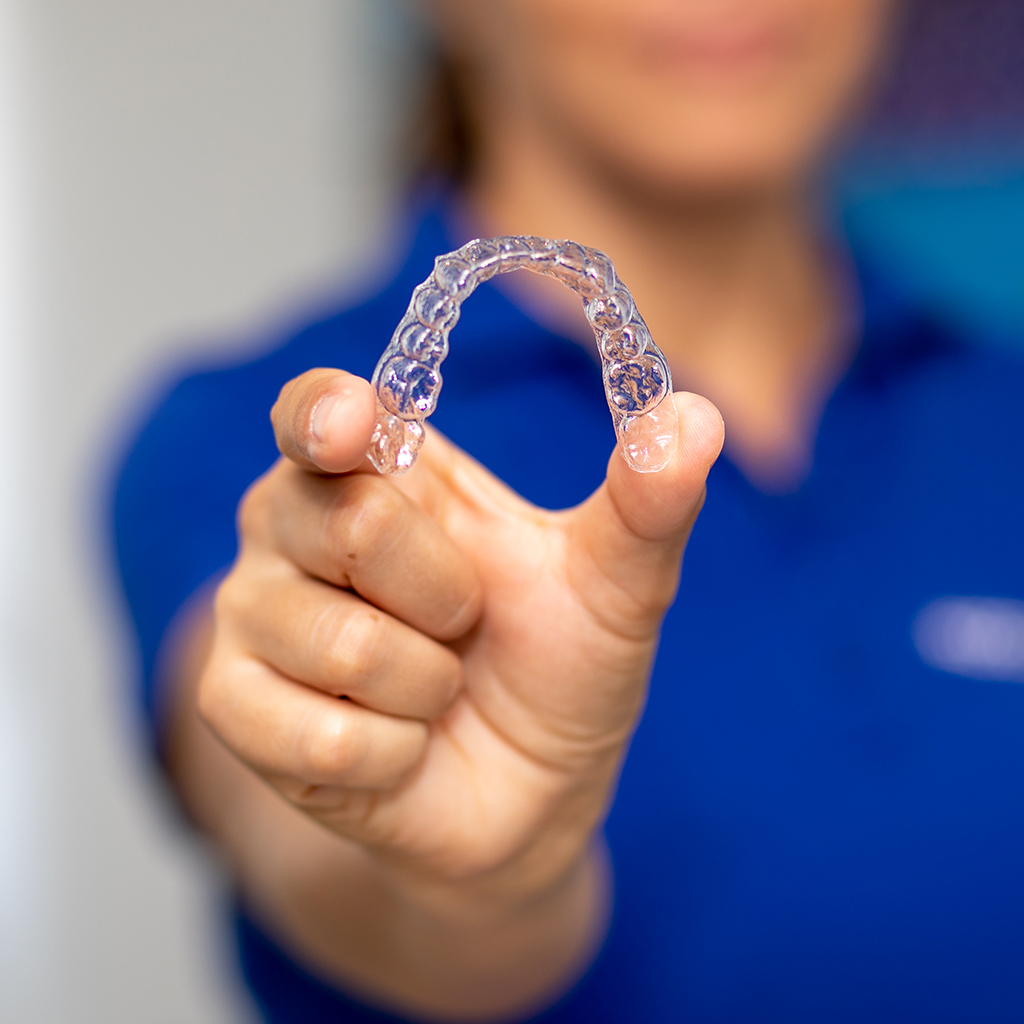

Clear aligners are becoming increasingly popular among younger age groups for several reasons. First, they are more aesthetically appealing than traditional fixed braces because they are transparent, giving children confidence during orthodontic treatment, especially at a younger age when appearance matters. Second, clear aligners are more comfortable as they have no sharp edges or metal parts that could irritate the mouth or gums, which is particularly important for children with heightened sensitivity to mechanical stimuli. Third, these are removable braces, making it much easier to maintain proper oral hygiene.
The first step is an orthodontic examination
Visiting an orthodontic specialist is a crucial first step to determine the need for orthodontic treatment. The orthodontist will carefully examine your child’s dental arches and recommend the most suitable treatment, whether it’s clear aligners, traditional fixed braces, or another approach. They will also assess if your child has any cavities and evaluate their oral hygiene habits. Before starting orthodontic therapy, all teeth should be treated and oral hygiene optimized. If cavities develop during treatment, repairing them is much simpler and faster, as there is no need to remove parts of the braces (brackets or wires).
Parents should be actively involved in educating their children about proper oral hygiene and the regular use of clear aligners. Children sometimes avoid wearing aligners or maintaining oral hygiene, and since these are removable braces, parents play a key role in ensuring consistent use. In the beginning, while the child is adjusting to this new responsibility, parents should frequently check how often the aligners are removed and encourage proper use if the child is not wearing them enough.
Dental assistants explain the importance of proper oral hygiene and the potential consequences of neglecting it. Maintaining good oral hygiene is especially crucial during orthodontic treatment. Because aligners are removable, it is easier to clean the teeth and interdental spaces. Teeth should be brushed after main meals and after consuming sugary foods or drinks to prevent food particles from remaining between teeth and the aligner, which could lead to cavities. If brushing immediately after meals isn’t possible, rinsing the mouth to remove food particles, reinserting the aligner, and brushing once home (after school or outings) is recommended.It’s important to show both the child and the parent how to perform oral hygiene correctly. Demonstrations can first be done on a model in the clinic, but in-mouth demonstrations are most effective, allowing the child to feel how the toothbrush, interdental brushes, and floss reach all areas. Nowadays, electric toothbrushes with interactive apps can also teach children proper brushing techniques in a fun and engaging way.
The second step is learning about aligners
Aligner therapy can begin while the child still has mixed dentition, meaning not all permanent teeth have erupted. Early treatment can help correct irregularities that might otherwise develop into larger problems, making the orthodontic correction process more difficult later on.
Aligners are effective only if worn consistently. It is recommended to wear them full-time (at least 20–22 hours per day) which means both day and night. The only exceptions are during meals and oral hygiene.
When placing the aligner, it should fully seat on the teeth. If there is a noticeable gap between the aligner and the tooth surface, contact your dentist.
When not in use, aligners should be kept in their designated case. They should never be wrapped in tissues or carried in pockets, as this can damage or contaminate them.
In case a child loses an aligner
If a child loses an aligner, contact the dentist so a replacement can be made.
Each child receives a specific number of aligners, depending on the type of orthodontic issue. Each aligner is typically worn for one week.
To clean aligners, simply use a toothbrush and cold water. Do not use hot water, as it can damage the aligner.
Dental check-ups for clear aligners are generally less frequent than for fixed braces and are usually scheduled individually, often every 2–3 months. For more complex cases, visits may be more frequent. Clear aligners are ideal for children who travel frequently or live abroad (e.g., children attending sports, music, or dance competitions or studying overseas) because they can receive a full set of aligners to change independently, reducing the need for frequent in-office visits.
Aligners do not interfere with playing sports. There is no risk of parts breaking off and injuring the soft tissues of the mouth, as can happen with fixed braces. They can be worn during physical activities and can even serve as a type of protective mouthguard.
The third step is motivating the child
Motivating a child to wear clear aligners is crucial for the success and duration of orthodontic treatment. Consistent wear according to the dentist’s instructions is essential to achieve the desired results.You can motivate your child by reminding them of the ultimate goal—a beautiful, straight smile and healthy teeth. Rewards for each successfully completed week can also help maintain motivation and discipline (the reward doesn’t have to be material; for example, the child can collect “stamps” and exchange them at the end of treatment for a predetermined reward).Another fun way to encourage consistent aligner use is by decorating the aligner case with stickers, which the child can add to at the end of each week.
Communication between the child, parents, and dental team is essential for understanding the importance of wearing aligners and providing support throughout the entire process.
Children are fully engaged in their aligner therapy because they need to remove and insert the aligners themselves, which teaches responsibility. Wearing clear aligners can become fun for children if they are well-informed about all the steps. As they see daily improvements in their smile, they become even more motivated to continue wearing the aligners and achieve the ultimate goal—a perfect smile.
Authors: Iva Plazonić, DMD, and Magdalena Keleminić, Dental Assistant
Source: maminkutak.com